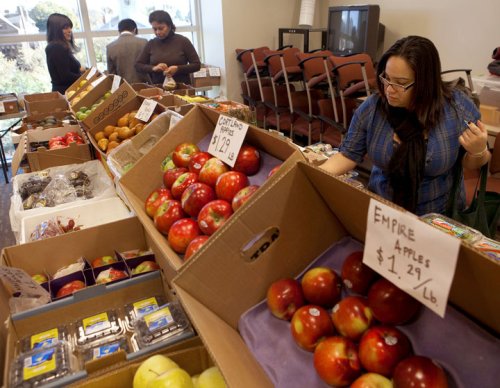Would convenient access to affordable fresh produce improve eating habits?
Would convenient access to affordable fresh produce improve eating habits?
If your employer made fresh produce available at reasonable prices just down the hall, would you eat more fresh fruits and vegetables? Would a few health tips sweeten the deal? A new Brown University study will investigate what it takes to help people eat better.

Good to Go If the price is right, the produce is fresh, and the market is just down the hall, will people eat more fruits and vegetables? Research now under way will find out. Credit: Mike Cohea/Brown University
PROVIDENCE, R.I. [Brown University] — Drop that doughnut. In a study called “Good to Go,” health researchers at Brown University will test whether setting up a low-priced, fresh produce market within workplaces will motivate higher employee fruit and vegetable consumption.
“There have been no other studies like this,” said Kim Gans, research professor of community health at the Warren Alpert Medical School of Brown University and interim director of the Institute for Community Health Promotion. “We’re reducing prices and bringing it to people where they work, year-round.”

Kim Gans. Interim Director, Institute for Community Health Promotion
Gans knows that eating more fruits and vegetables reduces the risk of several types of cancer, as well as diabetes, heart disease and high blood pressure. A major focus of public health research is to determine the best ways to help people heed that advice. Good to Go is one of four studies now underway by Gans to learn about what might motivate people to eat more fruits and vegetables.
“There are many people who know they should eat more fruits and vegetables but can’t seem to do whatever it takes to make it happen for a variety of reasons, including convenience, habit, taste, cost, availability, family likes and dislikes, cultural norms,” she said. “Meanwhile, there are other people out there who just don’t know about the benefits. Through advertising, we get hit over the head with other good-tasting, cheap, easy-to-find foods that are not very healthy for us.”
In Good to Go, funded by the National Cancer Institute, Gans will take away at least three excuses: cost, convenience, and ignorance. In parallel she’s also doing that on the streets of Providence with a program called “Fresh to You,” where her team has set up weekly low-priced fresh produce markets in a variety of community locations including an outdoor market in downtown Providence.
Efforts such as these might be what’s needed to reverse consumption habits in Rhode Island. According to the Centers for Disease Control, from 2000 to 2009 the percentage of state residents who ate fruit two or more times per day decreased from about 43 percent to 37 percent and the percentage that ate vegetables three or more times per day decreased from about 29 percent to 26 percent.
Workplace produce-ivity
For the workplace study, Gans is looking to recruit 24 employers with at least 200 workers at a single site in either Rhode Island or surrounding communities in Massachusetts and Connecticut. Each company would participate for a year.
The participating workplaces will be assigned to one of three groups. Eight companies will get an onsite produce market, eight will get the produce market plus educational programs on healthy eating, and the remaining eight companies will receive health promotion and education programs on health topics other than healthy eating. After the first year, the companies in this group would then have the option to host a market.
In each case, about 100 employees will be asked to fill out surveys on their households’ fruit and vegetable consumption and other related topics at the beginning of the year, midway through and at the end of the year. Employees will receive $20 for each survey they complete. Gans and her team will be measuring changes in fruit and vegetable consumption in each of the three groups.
While the health benefits for employees remain to be seen, the sheer convenience of being able to walk down the hall to a conference room to buy oranges or a head of lettuce should delight at least some workers. Because the vendor is a wholesaler, Gans says, the produce is fresher than what’s in the supermarket and almost always less expensive. She said her team monitors prices weekly and beats all but the loss-leader prices in local markets.
For employers, Gans said, the program is a way of providing an employee health promotion and morale-boosting program for free. She will also share her aggregated program data with employers (but not any individual employee data), so they can gain insight into the health of their workforce.
“Employers pay the health insurance for their employees,” she said. “If this program does have effects in improving people’s health, that affects the bottom line. It’s a win-win.”
Employers looking for additional information or interested in taking part can reach Gans by e-mail at goodtogo@brown.edu
* The above story is reprinted from materials provided by Brown University
** More information at Brown University (Providence, Rhode Island, USA)



















